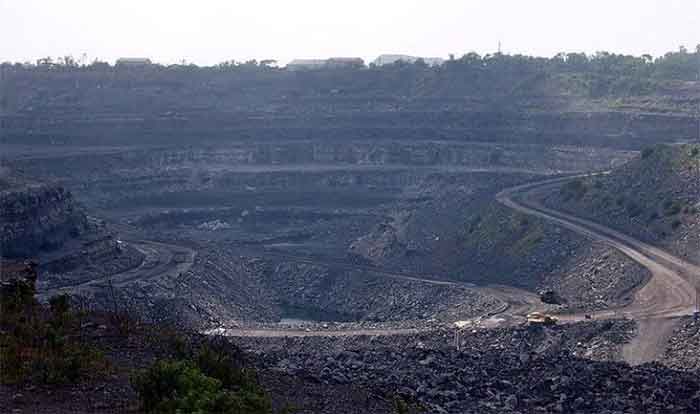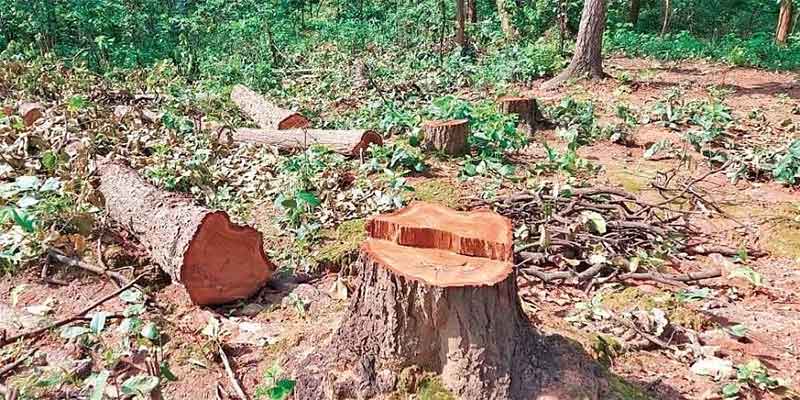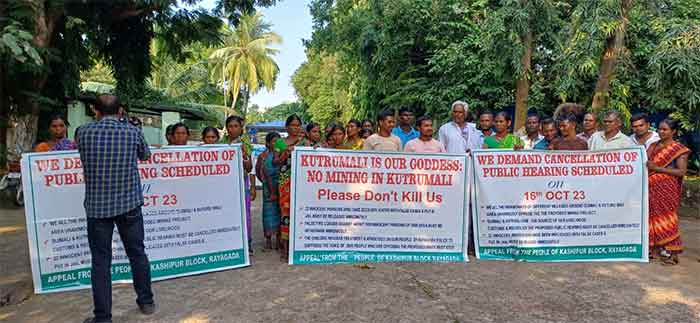
‘The development of India may require mining, but are we (the adivasis) not a part of india? We don’t even know who has the mine, or how they acquired it”,
-Indu Netam, the convenor of Adivasi Jan Van Adhikar Manch and a member of Mineral Inheritors Rights Association (MIRA)
Understanding Mining in India
The mining industry in India has constantly been in the spotlight for violations of many kind, ranging from environmental degredation, to labor violation and cases of child labour.Yet mining continues to be practiced on a massive scale. India is one of the largest contributors of mineral resources in the world, contributing to one quarter of the world’s mineral wealth. As of 2022, the government of India states that India has 1531 operational mines, producing 95 varieties of minerals, which includes 4 fuels, 10 metallic minerals, non metallic minerals, 3 atomic minerals and 55 minor minerals. The GDP from mining in India has averaged 773.49 billion rupees from 2011 until 2020 as per records from the government. The Press Bureau of India estimates that this contributes to nearly 2.6% of India’s GDP (Press Bureau of India, 2011). The mineral sector is also the second largest employer in the country following the agrarian sector engaging 11.49 lakh of people which is equivalent to 7.06% of the total employment share across the country
India is the second largest producer of coal across the globe and aims at reaching a production rate of 1.2 billion tonnes by 2023-2021. India is also the second largest producer of as well as consumer of steel across the globe. India produced 76.04 MT of steel in the year 2020, of which 9.4 MT was given for production. The index of the mining and quarrying sector has also increased to 124.7MT which is 2.8% higher than the previous year. The latest statistics by the Indian Bureau of Mines (IBM) states that there has been a 14.2 percent increase in production in the year 2021. Energy demands in the country increased by 700% in the last four decades. The production of coal is also steadily increasing over the years, barring 2020 when coal production dropped drastically as an outcome of the COVID-19 pandemic. The government of India continues to import coal to meet its fuel demands.
In 2021, coal comprised 4.5% of India’s imports. In 2020, the central government introduced the Mineral Laws (Amendment) Bill as a means to increase the energy production in the country thereby boosting economic growth. This comes at a period when the demand for global energy is expected to surge by 4.6% as stated in a report by the International Energy Agency. “The Mineral Laws (Amendment) Bill, 2020, will open a new era in the Indian coal & mining sector specially to promote ease of Doing Business.” said Union Coal & Mines Minister Sh. Pralhad Joshi “This Bill will transform the mining sector in the country, boosting coal production and reducing dependence on imports.” The Mineral Laws (Amendment) Bill 2020 was fast tracked through civil processes and signed by President Kovind
What does the New Mineral Amendment Bill 2020 mean?
The fast tracking of the coal amendment bills without due process has been critiqued by several parties. “The decision is discretionary, has no basis in law, and is against the principles of natural justice. At the very basic level, the EIA notification does not provide for exemptions based on standards such as ‘five-star rating’ as is being directed through an office memorandum. The law embraces the need for a free, fair, and transparent public hearing ensuring maximum participation. Limiting the public consultation to only written responses is discriminatory and may not hold up if put to a constitutional review,” said Kanchi Kohli, who works as a legal researcher at the Centre for Policy Research.
The passing of the new mineral amendment bill will open 500 potential mines, which were previously inaccessible. In an article in the Financial Express, Palhad Joshi the Union Minister for Coal and Mines estimates that the deregulation of the mining sector will increase the contribution of mining from 1.75% of the GDP to 2.5% of the GDP and National production output is expected to grow by 200%. Mining is the second largest sector in terms of gaining employment in the country supporting 5.5 crore people and proponents of the bill argue that it has been underperforming for decades because of the strict mining regulations present in the country. Since the mining industry supports other industries, a growth in mining would equate to a growth in allied sectors such as steel, aluminum, commercial vehicles, transportation etc.
On the flip side, there has been a lot of resistance by activists to the establishment of the new Mineral Laws (Amendment) Bill 2020. The current functioning of India’s mining industry has already been controversial. Before the Mineral Laws (Amendment) Bill 2020, the Mines and Minerals (Development and Regulation) (MMDR) was in place.The MMDR was established to regulate mining activities in India using “scientific methods.” The act provides the overarching framework for mining practice in India, from planning, processes, type of technology used, eligibility criteria for mining leasing. (MINES AND MINERALS (DEVELOPMENT AND REGULATION) ACT, 1957) However a loophole in the mining policy which was reported about by the organization Dhaatri in their report is that the policy does not give any reference to which the practice of mining should occur from a social context. The Act simply provides broad guidelines in terms of environment, rehabilitation and social impacts which can easily be misrepresented to the advantage of larger mining corporations.
The observations made by Dhaatri is further substantiated by a report by the Human Rights Watch done in Goa and Karnataka in 2009. A local home ministry official stated that more than half of the mining activities in Goa were illegal, but continued to remain in action because of corruption and lack of inspection by the respective authorities. The state of affairs is reflective of mining policies at the national level. Foreign companies choose to invest in mining activities in the country because of the lackadaisical implementation of legal provisions and policies. In the background of the COVID-19 pandemic, the state has introduced the new Mineral Law Amendment, which allows for an auctioning off of 500 potential mining leases to public and private investors.
The opening up of mining to the private sector has been coupled with deregulation of mining practice, and extension of the mining leases. The new amendments have also liberalized the mining sector by opening it completely for foreign investment. The crux of the argument is that the new mineral policy which calls for the commercialisation of tribal lands has shifted the management of natural resources from Adivasi communities to industrial groups. This act is also in violation of the Fifth Amendment and the Sixth Schedule of the Indian Constitution and disempowers the Adivasi communities by removing their rights over their lands. It is also more likely to increase already existing social and ecological inequalities that are an outcome of the mining industry in India.
How do International Entities influence our Policy?
The World Bank and The International Monetary Fund (1944) was instituted in 1944 with the mission to rebuild the world economy in the aftermath of the Second World War. Presently, the main goals of the World Bank have been “eliminating extreme poverty by 2030 and boosting shared prosperity.” There are many ways in which the World Bank works towards the achievement of this goal such as supporting government projects or large scale development projects which provide employability, facilitating international trade and giving policy advice. Following the Washington Consensus, the Bank and IMF encouraged a certain kind of macroeconomic policy which includes aspects such as labor flexibilization and privatizing the social sector. It is important to recognise the role that international actors and businesses play in the development of policies.
From the period of 2014-2019, India has taken loans up to 21,750 million dollars from the World Bank for various projects by the central government and individual state governments. India is the third largest lendee of the World Bank. This money has been used for the development of infrastructure such as electric power plants, transport, communication and the steel industry. Owing to this, the country has to comply with the larger mandates of the World Bank. The World Bank has largely been critiqued as exporting the US version of capitalism to the rest of the globe.
This has been reflected in India’s energy policy. In their paper, contesting women’s land rights, researchers Bhandari Kullari and Seema Mundoli noted the roles that International Multinational Corporates play in the formulation of policy in the state through deliberate arm-twisting of governments to remove or dilute the mineral policy.
In the current system, there is very little accountability demanded of these corporate entities for the human rights violations that occur in spaces such as mining. In his book “Rocks and Hard Places: The Globalization of Mining,” Roger Moody highlights the fact that in spite of objections from its own members and committees, the World Bank continued investment in mining companies which accounted for 56% of its returns as per a report by its International Finance Corporation (IFC). The World Bank continued to work with its charade that it was contributing to its mission of uplifting the poor, by only investing in mining corporations which supported the upliftment of marginalized communities. However the pushing for privatization of mines and over dependence on mineral resources in countries like Peru and Zambia by the World Bank very obviously contradicts the claim.
Many projects which have been funded by the World Bank are directly in violation of several internationally mandated human rights laws. These projects cause issues such as mass evictions, destructions of forests, violations of the rights of indigenous people and human rights violations such as child labour and forced labour. In spite of the development of toolkits on how to do mining while protecting the rights of communities and safeguarding the environment, the bank themselves have acknowledged that their projects contribute to gendered violence, sexual abuse and the spread of diseases such as HIV/AIDS. In an interview with Alan Beattie, Amar Bhattacharya who is a former official of the world bank and a doctorate for the group of 24, a caucus of developing countries said that “We don’t see the World Bank as being just for the very poorest countries or the very poorest people, but playing a primary role in poverty reduction and growth throughout the developing world.” He further added that the bank cannot address newer problems such as climate change while continuing to be involved in the development of infrastructure. “India is going to triple its usage of coal in the next 20 years,” he said in the interview. “The only question is: does it do it cleanly or dirtily?”
It is important that this question is further evaluated when designing and implementing policy. There can be no denying the fact that presently mining is a necessity for us to meet our energy requirements. It also plays an integral role in the economic development of the country in terms of providing jobs, and meeting our energy requirements. However it is important to recognise the fact that mining goes hand in hand with ecological degradation, human rights and labor violations. In the process mining also forces displacement and destruction of agrarian land. The two important questions to ask is who reaps the benefits of mining and who bears the costs of mining?
Nikita Chatterjee is a part of the Smitu Kothari Fellowship with the Center for Financial Accountability. She has a Masters in Development Studies from Azim Premji University. She has an interest in writing on issues revolving around tribal rights, ecology, gender, disability and education.

















































